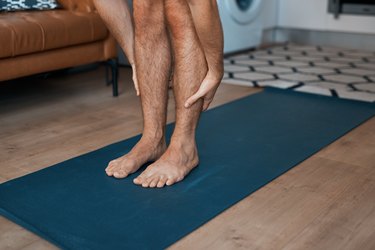
Regular exercise is key for reducing the health risks of obesity, and stretching is often the first step toward a healthier workout routine. If you're obese, however, the stress placed on your joints by your weight can make some stretches painful and even dangerous. You don't have to give up on physical fitness though. Instead, the key is to start with easy stretches and gradually progress to more challenging stretches and workouts.
Step 1
Try yoga. A yoga class can help you master proper form and offer you plenty of guidance. If you feel self-conscious in a group class, though, consider a yoga DVD or a private yoga instructor instead. Yoga gently stretches your muscles and can help alleviate pain and tension, making it easier for you to graduate to more intense exercises and stretches later. If a particular pose is painful, ask your instructor how you can modify it to make it a bit easier, and steer clear of poses that encourage you to bear your entire weight on your hands. Instead, try basic poses such as Child's pose, Mountain pose and side twists. Steer clear of hot yoga, which can be too taxing for people already at risk of cardiovascular problems.
Video of the Day
Step 2
Warm up before you begin your stretching routine. Warm muscles are less likely to become injured. Try walking, cycling or playing with your dog for five to 10 minutes. Then try a few dynamic stretches. For example, stand up straight and bend to one side and then the other, with your hands on your hips.
Step 3
Stretch your hamstrings by sitting down and extending your legs straight in front of you. Bend down over your legs and reach for your toes, stopping when you feel a stretch. Hold for 30 seconds. Then stand up and stretch your quadriceps by pulling one leg up toward your rear. The back of your thigh should be against the back of your calf. If you can't get your foot close to your rear yet, simply pull it as high as you can comfortably get it. Hold for 30 seconds and use a chair or wall to balance yourself if you need to.
Step 4
Sit on the floor and use an exercise mat if you need additional support. Stretch your hips by sitting down with your spine straight and your knees bent at 45-degree angles. Touch the bottoms of your feet together and pull them in toward your groin until you feel a stretch. Hold for 30 seconds. Next, kneel on your left knee with a towel under your knee for support. Bend your right knee and place your right foot flat on the ground straight out in front of your body. Lean forward until you feel a stretch and hold for 30 seconds, then switch legs. If you need additional support, try doing this stretch in front of a couch or other sturdy piece of furniture that you can grasp for balance.
Step 5
Stretch your chest and shoulders by bending your elbows at your rib cage and then pushing your arms backward as if you're trying to touch your elbows together at your back. When you feel a stretch, hold for 30 seconds. Next, bend your left elbow slightly and extend your left arm toward the right side across your chest. Use your right hand to support your elbow and hold your arm steady. Hold for 30 seconds, then switch sides.
Warning
If any stretch is painful, avoid it. Never overextend yourself or force a stretch.
Video of the Day